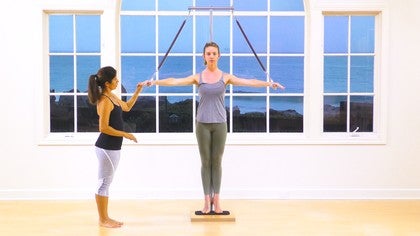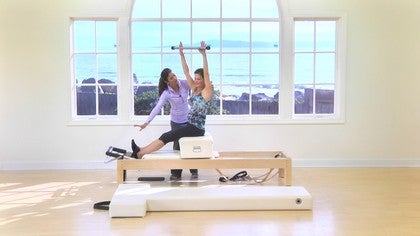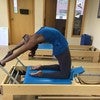Description
If you don't have access to a Ped-O-Pul or a 2 x 4 (used during the Wall exercises), we encourage you to grab a Moon Box and try the first half of this informative class.
About This Video
Transcript
Read Full Transcript
Today we are going to do wall and some standing foot work. Um, it can become really monotonous. Not Very exciting, but I love the wall. I think it's just really exciting. There's so much nitty gritty and I hope I can share that enthusiasm with you and how much it improves the rest of your technique and the rest of your work. So where you are going to kind of see how standing foot work as well as using a two by four for standing foot work. This is a nice two by four that has some cushion on it. You can just get a piece of wood out of your garage if you have that. Um, so or just for the next time you can try it.
We're going to have two pound weights as well. Not Anything heavier. If you don't have weights at home, you can pull out maybe two soup cans of equal weight out of your pantry. Anything like that would work just fine. Just nothing really heavy. We're not looking to build muscle here. We're looking to kinda offer opposition. So we're going to start with our standing foot work.
So be able to have your hand on a wall for balance. And I'm gonna align myself up with align here on the floor, but maybe just find something that you feel you can kind of center yourself. Whether your Pilati stance looks more like this or something like that. You want to just have an even turnout about two to three inches apart with your toes. Heels together. Okay. [inaudible] stance. So what we really want to think about here is the weight of your body on the ball of every toe. So on the ball, the big toe, the next toe, the very next one, all the way down to your little baby toe.
There is weight so that you're not rolling in, out or in. There is a little lift in your arch, okay? As if you have a little grape under it. You probably have heard me say a few times not squishing it and creating wine, you want to feel that muscle alive and that's going to become really important later on. We have weight on the side of our foot against, we're not rolling in and out. I not, I don't have weight on the side of my foot and weight on my heel. Okay?
I want to feel like I could just lift up and down with my heels like I could slip a card underneath there. There is weight or maybe use the image of an eggshell underneath your heels and you don't want to crack it just barely there. So then we're going to work up our legs. We want to see that our ankle bones are not touching. They don't want to roll in. Super important.
They're going to be right over our foot, right in the middle, that center point over our heel. Our knees don't want to lock back. Really overusing our survivor muscle quad here. We want to keep them just a little bit soft. All right? Keep working your way up. Super important is going to be our pelvis. How are these two bones, which of course is the bottom of our box.
All of this is going to improve our stability and our balance. So if our box is out of alignment, then we're not going to feel balanced. So these two bumps need to point, not down towards the floor, but straight ahead. I also don't want you to have them looking up at the ceiling. I want you to have them looking straight ahead and about 90% of people have a really hard time with that. They think that those bones are pointing forward, but they're really just a little bit here because our lower stomach's just a little drooping, so we got to really pull in that powerhouse. If as if you drew a line from one hip to the other and pull your belly behind that line and then pull up in that powerhouse so that those hip bones, the bottom of your plot is frame, are facing directly ahead, then you're going to have those straight line with your shoulders. Okay, so we've really engaged this and we're going to keep from this.
Each of these bones, our legs are going to spiral to the outside so that since our feet are turned out, our knees need to follow. What does that mean? Well, if my toes were together, then my knees could look straight ahead because your knees should point between your big toe on your little toe. But if I turn out my toes a little bit, then my knee should turn out a little bit and they should keep going. Okay? As we open, since we're about two to three inches apart, I want my knees to turn just a little bit out when I will need to engage all of these outer thigh muscles, my seat. Okay. All of that working. So I'm going to put my hand here on the wall for balance and I'm going to think about my arch. My arches are lifting, which is also lifting my inner thigh muscles. Never want to think about my inner thighs drooping or not being toned when the lift all the way up through our pelvis, through our powerhouse, up through our chest, through the crown of our head, like a marionette being pulled up by a string.
This does nothing for anybody, right? So really pull up through your body and we're going to keep your heels together, work all those muscles to lift up your heels. Two, three, hold it. Here. I'm really focusing on these hips, not losing it, so I'm going to keep my hips here with my Paris. As I think about maybe my spine, continuing to my tail bone, which is really a tail with a weight being pulled. I don't want to shorten my back. I want it long, not a pelvic tilt, but I want it long and it's going to lengthen as I keep my energy up and I play or bend my knees as low as I can. Then I'm going to lower down my heels so it's either knees or feet.
Okay? Get my heels down, stretch, stretch, stretch, and now I'm going to watch this. I'm going to pull up in my pals when working like mad, my outer thighs and seat and I'm gonna pull up using all of that power house Internet rapping in squeezing. I'm thinking in that tail bone. As I bend my knees lift and my powerhouse, I'm going to roll down through my foot like as if they're pliable. I can roll through each part of my foot, not just boom heels and then wrapped in squeeze, pulling up one more in this direction. Scoop in the belly, in and up, all from here and ple, a bending. Now this is called standing foot work and down with the heels.
Rule through your foot. Knees still in line with the toes and wrap. Squeeze up because standing foot work, just like the reformers, I'm imagining I'm also lying down on the reformer. I wouldn't have a big gape underneath my back. I'd be able to use that gravity to be pulled into my back. Let's reverse bending the knees again in alignment with those knees not rolling in or too far out and then roll up through the heel.
Your Body didn't move just the feet and now pull into that imaginary mat behind you. Lift, lift, lift, and now when you go down, it's like you're pushing a huge weight down with your heels because everything else is lifting up. Very positive as polite. Lifting up boys ple a as low as you can. Keep your heels down, stretch those Achilles 10 roll up through the foot. Don't lift your body, keep it square and now pull up, up, up, and resist going down like pushing a heavyweight down with my heels. How's the way, are you guys working really aware on pressure on all the ball of every toe side of the foot or your ankle bones rolling. One more.
Bend the knees going as low as you can stretch. Roll up the heel and now work unit. Push the ball of the foot into the floor. Wrap and squeeze. Really lifting everything and resist going. Dad. Let's take that up a notch and do it on the two by four.
So I'm going to step forward. Put the ball on my foot on the two by four. If I don't have my stomach in my powerhouse, that four-inch band and muscles, I'm going to fall off and I'm going to lose my balance. Sometimes it's hard to keep it in while talking, but I'm going to give it my best shot. So let's start with your heels. Nice and high. Notice as my heels aren't separated so that I'm not only using my calf muscles, I'm working from the knee up instead of from the ankle to my knee.
Now I'm going to play a bending and now I'm going to try lower my heels as low as I can. Big stretch here on the two by four. Now the wrap and squeeze. Good. Pulling into my imaginary mat behind me, bending my knees, lengthening my tailbone down, rolling down my feet and pull into your back and wrap in. Squeeze. Don't let these bones go down. One more. All the way up. Bend the knees, roll down through the foot.
Get the outer thigh and the bottom. Really working. Let's reverse it. Keeping your heels down. Bend the knees. Maybe you can even lower the heels lower than that. Two by four. That's why it's there to kind of check that range of motion, roll up through the foot, powerhouse in enough, in and up, up, up, out, marionette again, and now lower down those heels. Good. Stretch that tailbone, right.
You're lengthening your spine and there's no short back there. Then the knees lengthening your spine even more. Rolling up through your foot and pulling up, up, up, up, and one more in this direction. And we'll go to the wall. Bend the knees. Good. Roll up through the foot up.
You go from your stomach and push down as if you have that big weight underneath your feet. Great job. Okay, we're gonna get rid of the two by four and we're going to do the wall. So I'm going to grab my two pound weights. So the first thing I like to do is to walk right into the wall, straight into it, and then turn around. I do this because no one ever likes their belly to be the first thing that hits the wall. If you're walking and they don't want to hit their head. So you're going to automatically pull your stomach in and you're on an automatically lift your head up if you're walking towards the wall.
So now you also want to start with your heels directly against the wall. It's, you're going to end up having to take them forward. But challenge yourself first. We would love to have a natural curve here, natural curve behind your neck, but you should be able to have a supple spine that you can move however you want, not just stuck. So try your hardest to pull your belly into your back and see if maybe you can get pretty close to that, getting your back pretty flat. And we're gonna work from there. So I have about, I'm going to say a hand a little bit more than a hands with distance.
And I'm going to walk my feet out a little bit, get my Pilati stance, and I'm going to try again. So why I love the wall so much is because our posture generally is really poor. And so this is an amazing posture builder here. So we're going to have our hips against, straight across, not going down, not shortening that back. And we're going to try to pull our belly behind that imaginary line and see if we got any closer. I got closer, but not quite. So I'm gonna let my feet go out a little more.
And it's super important that it's a challenge to get your, uh, back against the wall, but not straining. So now I'm gonna hop. Now I'm pressing. I don't want you to think, do I have my back against the wall? I want you to know you have your back again. So all I want you to feel energy pushing in and through that wall. And now we're gonna use those two pound weights as opposition. Okay? Sorry.
Before we do that, find that energy, the lift of the arch, the lift of those inner thighs, the lift of your belly into your back. So all of this is pulling in. And like I said, that tailbone goes to a tail with a nice weight on the end. Here we go. So we're going to pull in. You can come up to here. If you can come up higher, great. If you can come up all the way here, back stays flat, flat, flat, and reach out to the walls. Okay. If your arms lift and you immediately arch, you've gone too far, so you're gonna pull into the wall long reaching out to the sides and one more scooping into the wall, reaching out carefully. You're not using those knees.
Let's reverse three more up opening and reach to the other side of the room. Really reached to the walls on this corners and reach to the other side of the room. One more. This is not easy. You're working as tall as you can reaching. Now we're going to continue that marionette feeling. Someone's pulling us, lengthen out the crown of your head and bring your chin to your chest. Try to keep the bottom of your shoulder blades against the wall or the back of your bra strap. As you roll down, we're thinking articulation here.
One bone at a time. Try to lift up out of your lower back and going down. Go to where you feel a nice back stretch or a lower back stretch. Don't go lower than your hip bones and do three shoulders circles, one, two, three, and rivers. And now Ramana always like to say as if you're pulling up an amazing heavyweight here so that I can really imagine you're working hard with your stomach to roll up your back against a weight and roll up through your neck.
Great. One more out the crown of your head. Chin to your chest. Okay. Articulate one bone at a time. This exercise is super important to strengthening any ruling. Exercise three circles, one, two, three and reverse. You're really pulling in and up in your powerhouse. You didn't just let your hipbones flop down and we'll back up pulling up that weight. So if you're having a hard time with rolling like a ball, the roll up the neck pool.
This is the exercise you want to do to get your back more flexible. Now we're going to separate your feet so they're parallel and take them a little. They should be about a good two feet in front of the wall. And we're going to do the wall [inaudible] try not to get too relaxed with this. We're going to be keeping our frame and then we're going to challenge doing it. One leg. So what I mean by relaxed, make sure you're not doing it with more, more on one side than the other. Here's our frame hip points.
Hipbones pointing directly forward and we'll do the first one with our arms by our side, pulling in our powerhouse. It's almost like I'm growing taller, using the earth to pull up from, but I'm still going to go down, but I'm not giving into gravity. I'm thinking in and up. Go to a right angle, tighten the back of my thighs, tighten my glutes, use my belly in and up and come up. This time I'm going to let my arms float up. Opposition pulling in and up. Beautiful. Stretch back the legs and seat and up. One more.
Now I'm going to bring my right leg, my legs a little bit closer together and I'm going to try it. One leg version. So I'm going to extend my right leg up at hip level if I can. Now what I'm thinking that I could easily grip my quad and hold the leg up with my leg, but I'm told dancers, cause I didn't dance, really lengthen their back and lift their leg up from the back of their thigh instead of just gripping in their hip flexor. You really want to think about that. If you're an advanced Polonius technician, then you're going to be thinking about your teasers and rollovers and many exercises where you're lifting from there. And now we're going to go down, hold two, three and pull up and going down. So you don't want one hip raising higher than the other and last one and pulling up from your powerhouse and switch.
So you're gonna Really wanna work this, that you're not going into one hip or the other, cause we're gonna do pull the Pedo pole and we'll do one legged pedal pole as well. So if you can't do it on the wall, pedicle is going to be impossible. All right? So again, from lengthening my spine to my tailbone to imaginary tale, I'm going to pull up that leg. I'm not going to shorten my back to do so. And now I'm going to go down and to keep my box square and I'm going to pull up powerhouse two more and powerhouse, and last time and power house. Now we're going to lower that leg. Walk your feet back to the wall, and now maybe our backs a little more flexible. We're going to have our feet and politely stance and the most important ending, especially as you finish your regular workout, pushing those weights against the wall to give you opposition to lean forward.
One solid piece of steel from your head to your heel and you have beautiful posture now. Now we're ready to take all of that to challenge ourselves on the pedicle. Okay, so now Colleen is going to be my body to take it to the next level. Let's see how it is on the pedicle. So we will start with the position. We were just, and we were against the wall, right?
We put our weights and we pushed and we leaned forward for that leaning tower of Pisa and she's going to do that for chest expansion here. Challenge that ability to stay stable. So I'm going to hold these for you, but go ahead and stand. I have the pad hanging off the edge, but yet your heels up all the way on and the whole foot on the platform. Good. Maybe a tiny bit more. I feel like your heels are a little off the back edge. Yeah. Great. And so pretend that you're against that wall and you just pushed your weights into the wall. Good. Make sure your ankle bones aren't rolling in.
You have a lift in your arch. Lift in your inner thigh. Soften the knees just a little there. Don't let those quads take over and you lift in the powerhouse and and up. Great. Really using all those outer thighs and the seat. Thinking about the spine, continuing to her tail bone to a tail lengthening.
I'm gonna have you pull this right hip back. Just a hair. Yep. Good. All right. And in the front, her stomach is really pulling in. As your arms go straight, the powerhouse pulls in even more gray. And I'm going to Kinda spot her by my hand on her tummy and on my back of her legs. I want you to inhale, pull those arms down and back. Look over your right shoulder. Look over your left shoulder.
Look forward and hold that position as you exhale, releasing your arms. Hold that nice strong tower of Pisa. Inhale, pulling down in back. Look left this time right forward and hold that position. As you exhale, keep pressing your hips forward. Keep pulling your belly in. That's it. One more set in with the air back of the arms.
Look over your right shoulder. Look over your left. I love how she doesn't move her shoulders. Look forward and release. It's all about pulling those springs with your powerhouse. One more in with the air. Look left later on. Look right, look forward and exhale later on.
You can get more into opening the chest. Maybe I'll take these, but the first thing is can you feel it in your stomach? So great job. Really good. I'm going to slide this back now, so that's directly against the pole and we're going to line your back up like we did with the wall. So the heels are going to go right against the wall flat for this one. Heels touching good, two to three inches apart, right? And you're going to have a little weight on the ball of every toe.
A little lift in that arch weight on the side of the foot, weight on the heel. Ankle bones aren't rolling in right, the knees aren't rolling in. They're in alignment with the feet, with the toes, I should say. Good and a little soft. I'm going to give her these handles right here and I love to see you won't be able to see it from this angle, but as your arms go forward, her back pulls directly into that pole. Long neck.
She's still a Marionette that we've been talking about and we're going to start by opening the arms and pull into your pole to grow taller, always in your peripheral vision, not behind you and going forward. Let's keep it moving and open and pulling in and up. And one more, making sure everything feels really balanced at reverse. Pulled down or working everything to go up good. And pulling that belly behind the line of those hips.
Maybe pull those hipbones up. Just a hair. Last one. [inaudible] opening. Great. Now we're going to do something called centering. So those were armed circles. We're going to lift onto the ball of the foot or onto demi point. Take the heels all the way back against the pole. Great.
Maybe a tiny bit further. A little higher lift. Thank you Coleen. So now we're really pushing the earth away with the ball of our foot and really may remember we did that standing foot work and we're lifting everything. We're thinking about keeping this long lifting up in our Paris. Open your arms just to your peripheral vision.
And I want them to stay a little lower than your shoulders. Good, very good. Nice. And I want you to keep them at that angle. Keep that angle as you play or bend the knees down. So remember, our wall sits lengthening, the back goes low as you want them. Pull those arms down by your side and lift in your powerhouse to come up. Beautiful. Release those arms. Go down, bending the knees and pull down. Lift in the belly, keeping those hip bones and release again just lower than your shoulder.
One more down you go. Keeping those arms to pull down with your powerhouse. Wrap in. Squeeze up, lifting into the bowl and arms. Go back to home. Let's reverse that. Pull the arms down first by pulling in Linkedin. Lengthen your tailbone as you bend down. Release your arms and come up. Good. Two more.
Pull down first and bend the knees. Good. And keep pulling into that pole and come up. And one more. Pull into the pole. Slide down, sliding into the pole. Release your arms, work the back of your thighs and see pushing into the ball of foot. And very nice.
So now we're going to take that and hopefully she was really hard on both sides cause we're going to do it one legged. All right, so coming just a little bit more center onto your right leg shift just a tiny bit, bringing it under you. Uh, or do you want it? Let's actually start with your right leg up first. So take your left leg a little more center. It's really important to use the opposition of those arms cause if there's none, then you add to the wobbliness, keeping her nice square. Try to lengthen that back line and continue lifting that leg from that backline little soft knee.
There's a straight line from toe to your belly button to your nose. And let's go ahead and bend that knee. Staying in contact with that pole and up. And two more looking beautiful and pulling up. One more. Trying to stay right on that pole and up and bring that foot down.
Nice job calling. So we're going to bring that right leg a little more under us. The important thing that I'm looking for is here, scooping in, soften the right knee, just a Harris. You're holding yourself more with your powerhouse and left leg. So pressing on those arms. Use Them. No toe, belly button, nose, and let's go. I don't want to get in your way that sit nice and pulling into the pole, pulling into the pool more. One more time, pulling in and working. That outer right thigh, that's it.
Bring that leg down. Now the hardest one that we're working on here is our to the side. Okay, and our grand finale here today. So getting a little under you with that right now, let's regain that nice stable box. You have to pull all of that balance and powerhouse posture, work good.
And we're going to extend the right leg forward first and then keeping this nice alignment. Try to open the leg to the side with a nice bent knee. Good. Equally pressing on those arms. Bend the left knee and use that outer thigh and pull into the pole. You got it. Two more pressing onto those springs. One more time, pulling into the pole, outer thigh and seat.
Bring that leg forward and bring it back down. One more leg. You can do it. Here we go. So nice alignment. Make sure the need doesn't lock as we extend that left flag, pulling it from under you. Good. Now take it to the side. Push first on the arms, keeping your stability. Yeah, a little wider if you can, and bend that right knee and pull up through that hours. Two more down.
[inaudible] pulling up through that [inaudible] last one and scoop and, and bring that leg forward and bring that foot down and come down on your flat feet and you are all finished. Nice job. Great.
Rhythm and Dynamics - Playlist 8: Mixed Equipment Workouts
Comments
You need to be a subscriber to post a comment.
Please Log In or Create an Account to start your free trial.
















